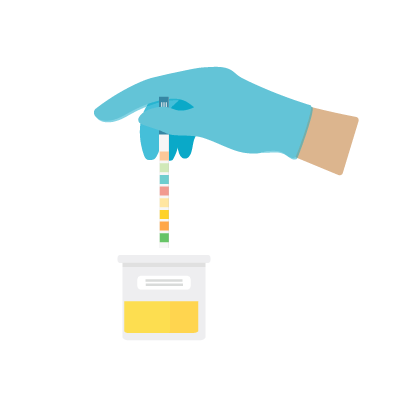- What is foamy urine?
- What does foamy urine look like?
- What does normal urine look like?
- What is the difference between bubbles and foam in urine?
- Is foamy urine normal?
- What other symptoms can occur with foamy urine?
- What causes foamy urine?
- When to see a doctor
- How is foamy urine diagnosed?
- Treatment
- Conclusion
- Source
“My urine is bubbly and foamy – should I be worried?”
Many people feel anxious when their morning pee turns foamy.
Releasing foamy pee is normal from time to time, as the speed of urination and other factors can affect the urine.
But, if the foamy urine becomes persistent and highly noticeable, talk to a specialist.
Here, you can learn more about foamy urine and the signs and causes which could indicate a problem.
What is foamy urine?
If you have foamy pee, your bladder could be full, and the pee is hitting the toilet too quickly. This ends up stirring the water and creating foam.
But, when urine is foamy, it can also be a clear sign of protein in the pee – this is not normal.
Kidneys leak protein when they are supposed to keep it in the body. If the kidneys release protein into the pee, they are not functioning normally.
Foaming can happen because albumin (a protein that the liver makes) develops a soap-like effect, which reduces the surface tension of the urine.
What does foamy urine look like?
Foamy urine is recognized by the persistence and appearance of multiple layers of small to medium-sized bubbles in the urine. The foam density and number of bubbles in urine will vary from person to person.
If the urine reaches the toilet bowl too quickly, the water foams up. The foam looks like a mass of small bubbles with a slightly dingy consistency.
When there is one layer of bigger bubbles, these bubbles can quickly dissipate – this can be considered normal. (1)

What does normal urine look like?
Someone who is well-hydrated, healthy, and with a properly functioning urinary tract can have clear white urine. Clear pee means that the person is drinking too much water. Normal urine color can also range from amber to pale yellow.
When there is not enough fluid in the body, the urine becomes highly concentrated and changes color, such as darker shades of yellow. The color of the urine can vary day by day. But, it should remain within a healthy yellow range.
The preferred urine color is pale straw to a darker yellow. If the urine is turning honey or amber-colored, it’s time to get a glass of water. The darker the hue, the more likely it is to be a sign of dehydration.
What is the difference between bubbles and foam in urine?
There is a slight difference between foam vs bubbles urine. In the case of urine with white foam, the foam remains in the toilet after you flush it.
In comparison, bubbles are flushable, clear, and relatively larger than foam. Due to the increased speed of urine foam, everyone can have little bubbles in their urine.
Not drinking enough fluids can lead to bubbly urine. When paired with persistent frothing of urine, the bubbles could be a symptom of early kidney disease.

Is foamy urine normal?
Having foam and air bubbles in urine every once in a while shouldn’t be a problem. But, if the foamy and cloudy urine is forming regularly, then this could be a sign of disease.
Frothiness of urine is seen as a red flag for proteinuria (high protein level in the pee).
Based on a review, many patients with frothy urine and bubbles in pee had clinically significant proteinuria. About 22% of patients who complained of foam bubbles had overt proteinuria. 31.6% experienced overt proteinuria, microalbuminuria, or both. (2)
Foamy urine in pregnancy can also happen. When a woman is carrying, the kidneys work full force to keep up with filtering the waste.
If protein gets to the urine during pregnancy, it often means the kidneys are not working like they are supposed to.
Before 20 weeks of pregnancy, proteinuria can happen due to an underlying kidney complication. Or other health issues that have nothing to do with the pregnancy, like a UTI or heart ailment.
After 20 weeks, experts take a closer look at the protein levels in the urine since it could indicate preeclampsia.
This condition causes elevated blood pressure and could damage the organs, especially the kidneys and liver.
When dealing with foamy urine while pregnant, it’s best to talk to a specialist and receive the necessary treatment.
What other symptoms can occur with foamy urine?
If the pee appears foamy and there are small bubbles in urine, look for other symptoms as well. They can give you clues to any other health problems you might be facing.
Such as:
- Cloudy urine
- Fatigue
- Vomiting
- Nausea
- Loss of appetite
- Difficulty sleeping
- Reduced urine output
- Urine with a dark hue
- Dry orgasm
- Infertility
- Swelling in the stomach, face, feet, or hands
Get Your FREE PSA Lowering Diet Plan!
- Naturally lower PSA levels
- Reduce nighttime trips to the bathroom
- Enjoy better bladder control and urine flow
What causes foamy urine?
The urine is supposed to be flat but can look like foamy water in various circumstances. Different causes of foamy urine exist. These include:
Fast urine stream
When someone pees a lot at once, particularly forcefully or fast, the pee could appear foamy. The fast urine stream can also cause temporary bubbles.
A high or fast flow rate could mean the muscles around the urethra are weakened. A patient might also be suffering from problems with urinary incontinence.
Surfactants
Organic compounds, like surfactants, can lead to bubbling. These compounds diffuse in water and have hydrophobic and hydrophilic ends.
So, they can trap pockets of gas on top of the liquid. This is how they form bubbles.
Soap is rich in surfactants. If you use any cleaning products or soap in the toilet water, then the pee can look bubbly.
Diabetes
Foamy urine in diabetes patients is relatively common. Diabetes increases glucose levels in the blood. This extra sugar passes into the urine.
In many of those affected, the kidneys can’t process all that extra glucose, which ends up piling up in the urine and causing cloudy, foamy urine.
Research indicates that when diabetic nephropathy sets in, people experience fatigue, pedal edema, and foamy urine with a urine protein higher than 3.5 g a day. (3)

Dehydration
Lack of fluid intake makes the urine more concentrated. That’s why foamy urine with dehydration can be a classic problem.
When a person is dehydrated, their urine turns darker than usual. A slight dark yellow hue means mild dehydration. Medium-dark yellow urine usually indicates moderate dehydration.
The darker the color and the stronger the protein in urine smell, the more dehydrated you are. It’s best to drink more water and get clear white pee.
Kidney disease
The kidneys have a clear purpose – to filter the waste and keep the proteins in the system. These proteins have a valuable role to play in keeping the balance of fluids in the body.
When you suffer from kidney disease or kidney damage, proteins leak into the urine. A damaged kidney allows vast amounts of protein to reach the urine. If the urine looks consistently foamy, then it could be a warning sign of proteinuria.
Retrograde ejaculation
With retrograde ejaculation, during an orgasm the semen doesn’t emerge out of the penis but goes into the bladder instead. When semen enters the bladder, it could make urine froth.
Vaginal discharge in women, however, is unlikely to cause foamy urine. (4)
Medication
People who take medicine to treat pain, irritation, and burning sensations from UTIs can experience foamy urine. These medicines include phenazopyridine, such as Uristat, Pyridium, AZO Standard, and AZO.
When to see a doctor
If the pee looks consistently foamy over time, get a few checkups. See your doctor if the frothy urine doesn’t dissipate in a couple of days or if it gets bloody or cloudy.
Additionally, you should see your doctor if you have any symptoms like fatigue, loss of appetite, vomiting, nausea, or swelling.
How is foamy urine diagnosed?
Foamy or frothy urine isn’t a specific condition. But, it could be a symptom of another health problem.
The doctor can suggest you provide a urine sample to diagnose the cause of frothy urine. Evaluation starts with a simple urine test. The doctor inserts a dipstick into the urine to see if the protein levels are abnormally high.
If the protein is too high, the doctor will want to ensure the effect is persistent. Therefore, they can suggest a 24h urine test. You will need to collect all the urine your body produces the entire day.
If you are at risk of having kidney disease or damage, the doctor might suggest a kidney ultrasound. This can help determine the overall state and structure of the affected organ.
Treatment
The treatment will vary based on what’s causing the problem.
For mild dehydration, you will need to drink a glass of water. With moderate dehydration, the body requires you to drink 2 to 3 glasses of water as soon as possible. For someone who is very dehydrated and the urine appears dark and smelly, drinking a large bottle of water is a top priority.
To manage urinary incontinence, it’s best to drink more liquid in the morning and afternoon instead of right before bed. You should also skip caffeinated and alcoholic beverages, as they can increase urine production.
If you are struggling with chronic kidney disease, the treatment will depend on how advanced the health condition is. Treating it can slow down its progression and reduce the odds of kidney failure. Doctors can suggest medicine to curb the protein content in the urine.
The most effective way to do it is to reduce blood pressure. Frequently elevated blood pressure and kidney complications go hand in hand.
By keeping the blood pressure stable, the kidneys filter the blood effectively. Doctors can suggest ARBs, ACE inhibitors, or diuretics to achieve the desired result.
ARBs (angiotensin receptor blockers) can make the blood vessels wider. In some patients, they are also better tolerated, particularly in those who use ACE inhibitors. ACE (angiotensin-converting enzyme) inhibitors also widen and relax the blood vessels.
This makes them a viable option for restoring normal urine and blood flow. Diuretics aid the kidneys in removing fluid and salt from the blood.
For diabetes patients, it is crucial to use the right medication to control their metabolic condition and related symptoms.
To facilitate the treatment and decrease proteinuria, experts often suggest incorporating some lifestyle changes.
You will need to stop smoking, manage stress, limit your alcohol and salt intake, drink water, consume veggies and fruits, keep the body healthy, and be more active. This can help restore the filtering system and mitigate some health problems.
Conclusion
When foamy urine appears occasionally, it shouldn’t be a cause for concern. But, if the froth is happening regularly, then it’s best to talk to a specialist.
It could signify kidney disease, diabetes, dehydration, and more. The treatment, however, will vary depending on the cause.
Explore More









